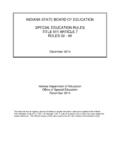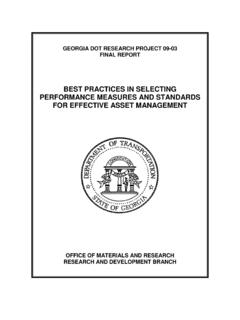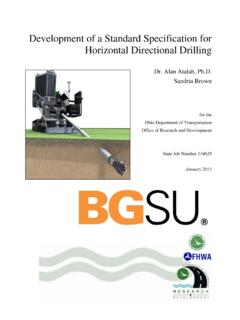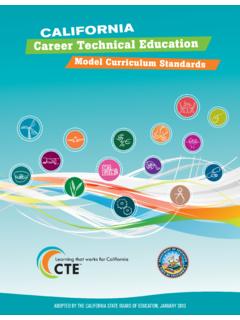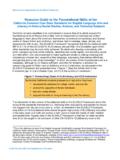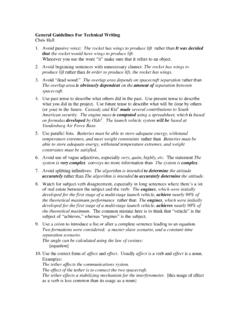Transcription of Sixth Grade Science Standards - IDOE
1 Sixth Grade Science Standards Sixth Grade 1 indiana Academic Standards for Science 2016 Science and Engineering Process Standards (SEPS) Posing questions (for Science ) and defining problems (for engineering) A practice of Science is posing and refining questions that lead to descriptions and explanations of how the natural and designed world(s) work and these questions can be scientifically tested. Engineering questions clarify problems to determine criteria for possible solutions and identify constraints to solve problems about the designed world. Developing and using models and tools A practice of both Science and engineering is to use and construct conceptual models that illustrate ideas and explanations. Models are used to develop questions, predictions and explanations; analyze and identify flaws in systems; build and revise scientific explanations and proposed engineered systems; and communicate ideas.
2 Measurements and observations are used to revise and improve models and designs. Models include, but are not limited to: diagrams, drawings, physical replicas, mathematical representations, analogies, and other technological models. Another practice of both Science and engineering is to identify and correctly use tools to construct, obtain, and evaluate questions and problems. Utilize appropriate tools while identifying their limitations. Tools include, but are not limited to: pencil and paper, models, ruler, a protractor, a calculator, laboratory equipment, safety gear, a spreadsheet, experiment data collection software, and other technological tools. Constructing and performing investigations Scientists and engineers are constructing and performing investigations in the field or laboratory, working collaboratively as well as individually.
3 Researching analogous problems in order to gain insight into possible solutions allows them to make conjectures about the form and meaning of the solution. A plan to a solution pathway is developed prior to constructing and performing investigations. Constructing investigations systematically encompasses identified variables and parameters generating quality data. While performing, scientists and engineers monitor and record progress. After performing, they evaluate to make changes to modify and repeat the investigation if necessary. Analyzing and interpreting data Investigations produce data that must be analyzed in order to derive meaning. Because data patterns and trends are not always obvious, scientists and engineers use a range of tools to identify the significant features in the data.
4 They identify sources of error in the investigations and calculate the degree of certainty in the results. Advances in Science and engineering makes analysis of proposed solutions more efficient and effective. They analyze their results by continually asking themselves questions; possible questions may be, but are not limited to: Does this make sense? "Could my results be duplicated?" and/or Does the design solve the problem with the given constraints? Sixth Grade Science Standards Sixth Grade 2 indiana Academic Standards for Science 2016 Using mathematics and computational thinking In both Science and engineering, mathematics and computation are fundamental tools for representing physical variables and their relationships. They are used for a range of tasks such as constructing simulations; solving equations exactly or approximately; and recognizing, expressing, and applying quantitative relationships.
5 Mathematical and computational approaches enable scientists and engineers to predict the behavior of systems and test the validity of such predictions. Scientists and engineers understand how mathematical ideas interconnect and build on one another to produce a coherent whole. Constructing explanations (for Science ) and designing solutions (for engineering) Scientists and engineers use their results from the investigation in constructing descriptions and explanations, citing the interpretation of data, connecting the investigation to how the natural and designed world(s) work. They construct or design logical coherent explanations or solutions of phenomena that incorporate their understanding of Science and/or engineering or a model that represents it, and are consistent with the available evidence.
6 Engaging in argument from evidence Scientists and engineers use reasoning and argument based on evidence to identify the best explanation for a natural phenomenon or the best solution to a design problem. Scientists and engineers use argumentation, the process by which evidence-based conclusions and solutions are reached, to listen to, compare, and evaluate competing ideas and methods based on merits. Scientists and engineers engage in argumentation when investigating a phenomenon, testing a design solution, resolving questions about measurements, building data models, and using evidence to evaluate claims. Obtaining, evaluating, and communicating information Scientists and engineers need to be communicating clearly and articulating the ideas and methods they generate. Critiquing and communicating ideas individually and in groups is a critical professional activity.
7 Communicating information and ideas can be done in multiple ways: using tables, diagrams, graphs, models, and equations, as well as, orally, in writing, and through extended discussions. Scientists and engineers employ multiple sources to obtain information that is used to evaluate the merit and validity of claims, methods, and designs. Sixth Grade Science Standards Sixth Grade 3 indiana Academic Standards for Science 2016 LEARNING OUTCOMES : LEARNING OUTCOME FOR LITERACY IN Science / technical SUBJECTS Read and comprehend Science and technical texts independently and proficiently and write effectively for a variety of discipline-specific tasks, purposes, and audiences GRADES 6-8 : Read and comprehend Science and technical texts within a range of complexity appropriate for grades 6-8 independently and proficiently by the end of Grade 8.
8 : Write routinely over a variety of time frames for a range of discipline-specific tasks, purposes, and audiences. KEY IDEAS AND TEXTUAL SUPPORT : KEY IDEAS AND TEXTUAL SUPPORT (READING) Extract and construct meaning from Science and technical texts using a variety of comprehension skills GRADES 6-8 : Cite specific textual evidence to support analysis of Science and technical texts. : Determine the central ideas or conclusions of a text; provide an accurate, objective summary of the text. : Follow precisely a multistep procedure when carrying out experiments, taking measurements, or performing technical tasks. STRUCTURAL ELEMENTS AND ORGANIZATION : STRUCTURAL ELEMENTS AND ORGANIZATION (READING) Build understanding of Science and technical texts, using knowledge of structural organization and author s purpose and message GRADES 6-8 : Determine the meaning of symbols, key terms, and other domain-specific words and phrases as they are used in a specific scientific or technical context relevant to grades 6-8 texts and topics.
9 : Analyze the structure an author uses to organize a text, including how the major sections contribute to the whole and to an understanding of the topic. : Analyze the author s purpose in providing an explanation, describing a procedure, or discussing an experiment in a text. Sixth Grade Science Standards Sixth Grade 4 indiana Academic Standards for Science 2016 SYNTHESIS AND CONNECTION OF IDEAS : SYNTHESIS AND CONNECTION OF IDEAS (READING) Build understanding of Science and technical texts by synthesizing and connecting ideas and evaluating specific claims GRADES 6-8 : Integrate quantitative or technical information expressed in words in a text with a version of that information expressed visually ( , in a flowchart, diagram, model, graph, or table). : Distinguish among facts, reasoned judgment based on research findings, and speculation in a text.
10 : Compare and contrast the information gained from experiments, simulations, video, or multimedia sources with that gained from reading a text on the same topic. WRITING GENRES : WRITING GENRES (WRITING) Write for different purposes and to specific audiences or people GRADES 6-8 : Write arguments focused on discipline-specific content. : Write informative texts, including scientific procedures/experiments or technical processes that include precise descriptions and conclusions drawn from data and research. THE WRITING PROCESS : THE WRITING PROCESS (WRITING) Produce coherent and legible documents by planning, drafting, revising, editing, and collaborating with others GRADES 6-8 : Plan and develop; draft; revise using appropriate reference materials; rewrite; try a new approach; and edit to produce and strengthen writing that is clear and coherent, with some guidance and support from peers and adults.




